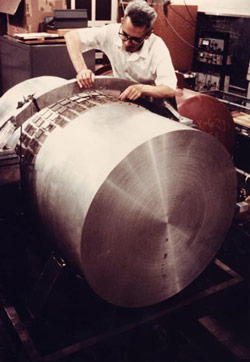A Fleeting Detection of Gravitational Waves
In honor of the World Year of Physics, which commemorates Einstein’s “miraculous year” in 1905, we’re presenting papers from the Physical Review archive related to Einstein’s accomplishments.
In 1918 Einstein used his new general theory of relativity to show that ripples in spacetime could exist and would move at the speed of light. Two papers in PRL, in 1969 and 1970, reported the first detections of such gravitational waves, coming apparently from the center of our galaxy. The discovery was later discredited, and the researcher behind it became a controversial figure. But his imagination and determination inspired other physicists to search for gravitational waves, a quest that continues today with efforts such as the Laser Interferometer Gravitational Wave Observatory (LIGO) project.
A gravitational wave, essentially a traveling distortion of the geometry of space, will jiggle the shape of any physical body it encounters. To detect such disturbances, Joseph Weber of the University of Maryland in College Park fashioned solid aluminum cylinders, about 2 meters long and 1 meter in diameter, and suspended them on steel wires. A passing gravitational wave would set one of these cylinders vibrating at its resonant frequency–about 1660 hertz–and piezoelectric crystals firmly attached around the cylinder’s waist would convert that ringing into an electrical signal.
Weber took great pains to isolate the cylinders from vibration and from local seismic and electromagnetic disturbances, and claimed that the only significant source of background noise came from random thermal motion of the aluminum atoms. This thermal motion caused a cylinder’s length to vary erratically by about meters, less than a proton’s diameter, but the expected gravitational wave signal was not much bigger. As evidence of a passing gravity wave, Weber looked for wiggles in the data that exceeded some “threshold” that characterized the background noise. But he didn’t define this threshold consistently or precisely.
Weber’s evidence for detection was based on observing these above-background signals in more than one bar within the same half-second period. After seeing some coincident events between two Maryland bars [1] Weber moved one of his cylinders to Argonne National Laboratory, near Chicago, about 1,000 kilometers away. In 1969 he reported in PRL some two dozen coincident detections at the two locations in an 81-day period. He calculated that some of the signals were so large that coincidences by chance should happen only once in hundreds or thousands of years. This was “good evidence” for gravitational waves, he argued. The following year he claimed to have detected 311 coincident signals in a 7-month period, with a directional concentration, moreover, pointing toward the center of the Milky Way.
The second announcement in particular created a stir. Tony Tyson, now at the University of California, Davis, joined with colleagues to build a “Weber bar,” as did a number of other groups around the world, but no one besides Weber ever saw anything but random noise. Weber was an electrical engineer turned physicist, who knew little of data analysis, Tyson says, “and that turned out to be his downfall.” Weber’s criteria for evaluating signal coincidences, it slowly emerged, were ill-defined and partly subjective. By the late 1970s, everyone but Weber agreed that his claimed detections were spurious.
What’s more, the strength and frequency of Weber’s signals, if real, would have required the sky to be teeming with nearby astrophysical events on the scale of supernovae spewing out gravity waves. But the invalidation of Weber’s claims only pushed other researchers to try harder, says Tyson. Today, the twin LIGO observatories in Louisiana and Washington state use optical techniques on a scale of kilometers to search for the telltale distortions of spacetime. Weber deserves credit for drawing others into this field of physics, says Tyson. “It was the difficulty that attracted us.”
–David Lindley
David Lindley is a freelance science writer in Alexandria, Virginia.
References
- J. Weber, “Gravitational-Wave-Detector Events,” Phys. Rev. Lett. 20, 1307 (1968)
More Information
Marcia Bartusiak, Einstein’s Unfinished Symphony: Listening to the Sounds of Space-Time (Joseph Henry Press, 2000)J.L. Levine, “Early Gravity-Wave Detection Experiments, 1960-1975,” Physics in Perspective, 6, 42 (2004)LIGO home pageEinstein@home–allows anyone to help search for gravity waves using idle time on their PCPhysics Today article on Einstein’s incorrect 1936 manuscript on gravity waves that was rejected by the Physical Review



